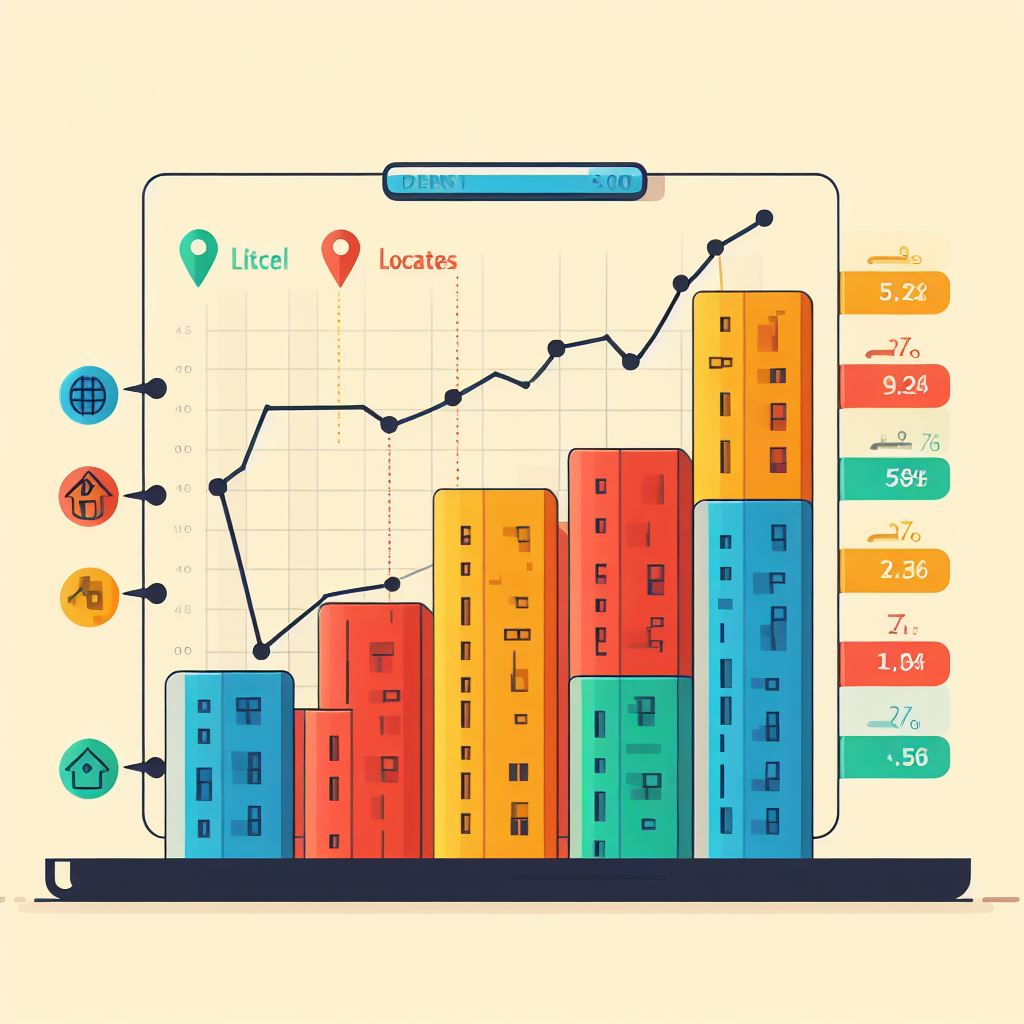Calculating Apartment Rental Prices: A Comprehensive Guide

Are you tired of the endless search for the perfect apartment, only to be faced with exorbitant rental prices? Look no further.
This comprehensive guide will provide you with the tools and knowledge needed to calculate apartment rental prices with ease. By considering factors such as location, size, amenities, market trends, and additional factors, you will be equipped to make informed decisions and find the best value for your money.
Say goodbye to the stress of apartment hunting and hello to finding your perfect home.
Key Takeaways
- Location and proximity to amenities are important factors in determining rental prices.
- The size and type of the apartment also play a role in rental prices.
- The presence of amenities and services can increase rental prices.
- Lease terms and conditions, such as duration and security deposits, can impact rental prices.
Location
When calculating apartment rental prices, consider the location of the property you’re interested in. The location of an apartment plays a significant role in determining its rental price. Urban areas with high demand and limited supply tend to have higher rental prices compared to suburban or rural areas. Proximity to amenities such as schools, hospitals, shopping centers, and transportation hubs also influences rental prices.
In major cities like New York or San Francisco, prime locations such as Manhattan or Silicon Valley command premium rental prices due to their desirability and proximity to job opportunities. On the other hand, apartments located in less popular neighborhoods or areas with limited amenities may have lower rental prices.
To get a better understanding of rental prices in a specific location, it’s essential to analyze market data. Online platforms like Zillow or Rent.com provide valuable insights into the average rental prices in different neighborhoods or cities. Additionally, you can consult with real estate agents or property managers who’ve in-depth knowledge of the local rental market.
Remember that location isn’t the sole factor determining rental prices. Other aspects like the size, condition, and age of the apartment also contribute to the overall cost. However, analyzing the location factor is crucial when calculating apartment rental prices to ensure you make an informed decision.
Size
To determine the rental price of an apartment, you need to consider the size of the unit. The size of an apartment is often measured in terms of square footage. Generally, larger apartments command higher rental prices compared to smaller ones. This is because larger apartments offer more living space, which is highly valued by potential tenants. Data from rental listings show that apartments with more square footage tend to have higher average rental prices. For example, a studio apartment with an average size of around 500 square feet may have a rental price of $1,000 per month, while a two-bedroom apartment with an average size of around 1,000 square feet may have a rental price of $2,000 per month.
It is important to note that the rental price per square foot may also vary based on other factors such as location and amenities. In highly desirable areas, the price per square foot may be higher due to the high demand. Additionally, apartments with premium amenities such as a gym, swimming pool, or concierge services may have higher rental prices even if their size is smaller compared to apartments without these amenities.
With the understanding of how size impacts rental prices, let’s move on to the next section and explore the role of amenities in determining apartment rental prices.
Amenities
Consider the amenities available in the apartment to further determine its rental price. The amenities offered can greatly impact the desirability and value of a rental property. When evaluating amenities, it’s important to consider both the quantity and quality of the features provided.
Start by examining the basic amenities that are typically expected in any rental property. These may include essential features such as electricity, water, and heating. These amenities are considered essential and are typically included in the rental price.
Next, consider the additional amenities that can enhance the overall living experience. These could include features such as a fitness center, swimming pool, or on-site laundry facilities. These amenities are often seen as desirable and can command a higher rental price.
In addition to physical amenities, technological amenities can also play a significant role. High-speed internet access, cable or satellite TV, and smart home features are becoming increasingly important to renters. Apartments equipped with these technological amenities may be in higher demand and can justify a higher rental price.
It’s important to note that the value of amenities can vary depending on the location and target demographic of the apartment. For example, a building with a doorman may be highly valued in a busy city center, but less important in a suburban area.
Market Trends
Now let’s delve into the current subtopic of ‘Market Trends’ and explore how they can impact apartment rental prices. Understanding the market trends is crucial when it comes to determining the optimal rental price for your apartment. Here are three key factors to consider:
- Supply and Demand: The balance between the number of available rental units and the number of renters in the market significantly affects rental prices. When the demand for apartments exceeds the supply, landlords have the advantage and can increase rental prices. Conversely, when the supply exceeds the demand, landlords may need to lower their prices to attract tenants.
- Economic Conditions: The overall health of the economy can influence apartment rental prices. During periods of economic growth and low unemployment rates, people have more money to spend on housing, leading to higher rental prices. On the other hand, during economic downturns, people may downsize or face financial constraints, which can result in lower rental prices.
- Location: The location of an apartment plays a significant role in determining its rental price. Popular neighborhoods with desirable amenities, such as proximity to public transportation, shopping centers, and schools, tend to have higher rental prices. Additionally, areas experiencing gentrification or urban development may see a surge in rental prices due to increased demand.
Additional Factors
Understanding how additional factors can impact apartment rental prices is essential for determining the optimal rental price for your property. While market trends play a significant role in setting rental prices, considering additional factors can help you fine-tune the price to attract potential tenants and maximize your rental income.
One crucial additional factor to consider is the location of your apartment. The neighborhood’s desirability, proximity to amenities, and access to transportation can significantly influence rental prices. Apartments located in trendy, central locations with easy access to public transportation and popular amenities tend to command higher rental prices compared to those in less desirable areas.
The size and layout of your apartment are also important factors to consider. Larger apartments with more bedrooms and bathrooms generally have higher rental prices. Additionally, apartments with functional layouts that maximize space and offer desirable features such as ample storage, modern appliances, and high-quality finishes can justify higher rental prices.
Another factor to consider is the condition of your apartment. Well-maintained apartments with updated fixtures and appliances typically command higher rental prices compared to those in need of repairs or upgrades.
Furthermore, the availability of parking spaces, in-unit laundry facilities, and access to additional amenities such as a gym or swimming pool can also impact rental prices. Apartments with these added conveniences often attract more tenants and can justify higher rental prices.
Lastly, the demand for rental properties in your area is also a crucial factor to consider. If the demand for apartments is high and the supply is low, you can expect rental prices to be higher. Conversely, in areas with a surplus of rental properties, prices may be more competitive.
Frequently Asked Questions
Are There Any Restrictions on Pets in the Apartment Complex?
There are restrictions on pets in the apartment complex. You’ll need to check with the management for specific details. They may have limitations on the number, size, and breed of pets allowed.
What Is the Average Utility Cost for Apartments in This Area?
On average, the utility cost for apartments in this area is $150 per month. This includes electricity, water, and gas. It’s important to factor in this expense when calculating the overall cost of renting an apartment.
Is Renter’s Insurance Required for Apartments in This Building?
Renter’s insurance is required for apartments in this building. It provides protection for your personal belongings and liability coverage. It is a wise investment to ensure you are financially protected in case of unforeseen events.
Are There Any Maintenance Fees or Other Hidden Costs Associated With the Apartment?
Yes, there may be maintenance fees or hidden costs associated with the apartment. It’s important to carefully review the lease agreement to understand all the financial obligations before making a decision.
Can I Sublet the Apartment if I Need to Move Before the Lease Ends?
Yes, you can sublet the apartment if you need to move before the lease ends. This allows you to find someone to take over your lease and help you avoid breaking the contract.



